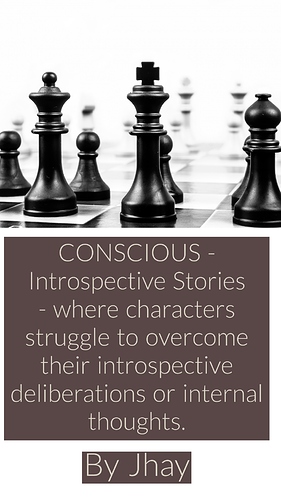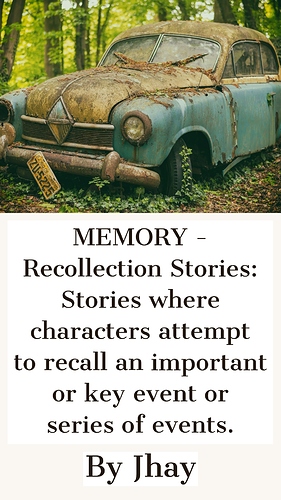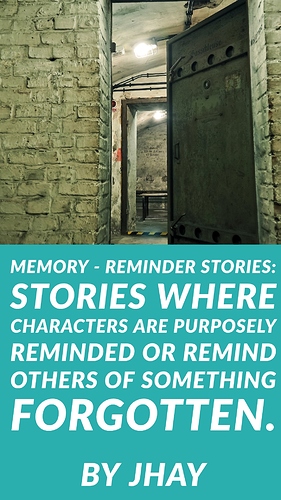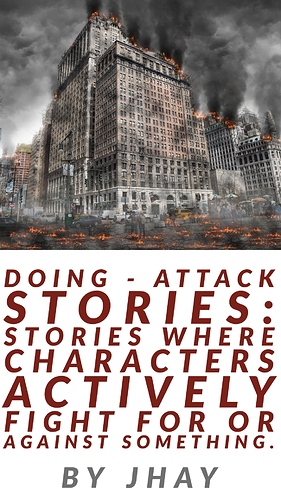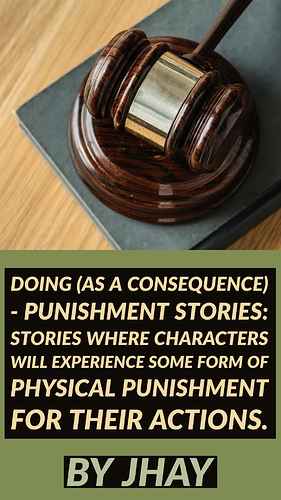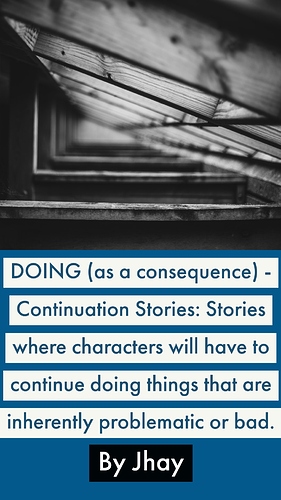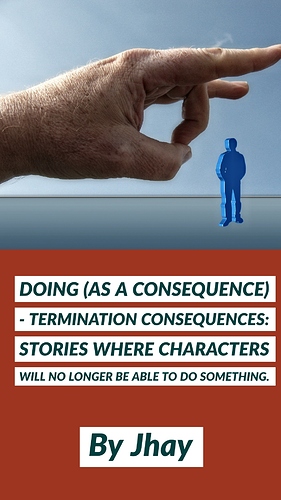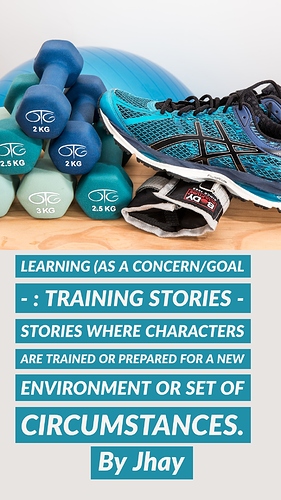@jhay . This is pure Love! So amazing bro! Most grateful for your hard work and dedication to helping the community. Bless you Sir.
Couple quick updates:
-
The videos have been updated with better clips, some new movies, some old ones taken out. The Makeover one is a more reasonable length (5 mins), and the clips have been shortened to 30-35 seconds for convenience.
-
Social Change is now “Activism”, as that term is a bit more flexible in terms of creativity.
-
I had to redefine what the subgenres were a little bit, because the movies were getting lost between them. Brokeback Mountain certainly did not feel like it fit in Makeover once you actually watched the movie (I think it’s probably in that fourth, unknown spot), and The 40-Year-Old Virgin’s goal actually extends to all four of the leading men (all of whom have to become more mature), so it’s more of an evolutionary goal than a makeover goal. My next job after the Universe subgenres is to write exactly how to differentiate between each subgenre, so that will no doubt help everyone identify their stories much quicker.
At the moment, no. And I can’t see myself being able to afford to keep one up and running for the foreseeable future, so at the moment, that is an option only if I can find a relatively cheap one. I’ll start looking after Christmas, and see what happens.
You could always try a free site like Blogger or Google Sites to start off, and migrate to your own domain later…
An art class that I took at a state university, two years ago, had the students start their own website as part of a class assignment, and they recommended Squarespace and some others. Squarespace was simple and affordable for me. Ask art departments for even cheaper options. Sometimes, there are specials for a year or so, too.
@jhay Me and another friend of mine are creating vertical graphics based on your insights. I’ll update the list as time goes on.
Presenting the Universe quad! This one was quite tough, in terms of finding a way to describe them that would separate them from the other domains. I think this will be the one that will go through the most changes as I start to understand it a little bit more, but for the moment, these are my findings.
Consequences will be coming soon (quite hard to research with limited Mind stories), but for now, I hope you enjoy these and have a very happy Christmas, one and all!
Universe
##Future
As a Concern/Goal
INNOCENCE STORIES: stories where characters are being wrongly punished or blamed for things they were not responsible for.
The Innocence Story frequently deals with a wrongful determination, such as an award-winning artist being falsely accused of plagiarism, or a non-profit organisation being wrongly blamed for terrorist acts. Saving the future of a wrongly accused man in His Girl Friday; proving the innocence of The Fugitive, and seeking a life as a free man in The Shawshank Redemption all explore the difficulties in handling false or inaccurate blame.
OS EXAMPLES: The Fugitive; His Girl Friday; The Shawshank Redemption.
MC EXAMPLES: To be confirmed.
DYNAMIC PAIR: To be confirmed.
–
STABILITY STORIES: stories where characters seek a state of stability in a volatile situation.
The Stability Story often deals with the pursuit of stability in an otherwise unstable or untenable situation, such as a collapsing government fighting for a more united future, or a spinster looking for her ideal happy ending. Helping Juno find a future for her unborn child; seeking a happy future out of Bridget Jones’s Diary, and Auntie Mame seeking stability for her nephew all explore the experience of searching for stability in turbulent times.
OS EXAMPLES: Auntie Mame; Boyz N The Hood; Bridget Jones’s Diary; The Glass Menagerie; The Graduate; Juno; Pride and Prejudice; Sula; Washington Square
MC EXAMPLES: All About Eve; Enchanted; Erin Brockovich; Kingsman: The Secret Service; Kramer vs. Kramer; Moonstruck; The Palm Beach Story; Pretty Woman; Shrek; Terms of Endearment; The Palm Beach Story
DYNAMIC PAIR: Saviour stories, stories where characters are seeking to protect or save a new future for themselves or others.
–
SAVIOUR STORIES: stories where characters are seeking to protect or save a new future for themselves or others.
The Saviour Story is one in which characters attempt to protect or save the future of themselves or others, such as a young babysitter seeking to ensure the future safety of homeless children, or a chef looking to environmentalism to save the planet. Trying to protect the future of a casino in The Cooler, and helping The Exorcist save the future of a possessed girl both explore the challenges faced when attempting to protect or save a future for oneself or others.
OS EXAMPLES: The Cooler; The Exorcist.
MC EXAMPLES: Back to the Future; Captain America: Civil War; The Matrix; Moana; Thor: Ragnarok.
DYNAMIC PAIR: Stability stories, stories where characters seek a state of stability in a volatile situation.
#Past
As a Concern/Goal
CHRONICLE STORIES: stories where characters attempt to uncover or piece together something that happened in the past.
The Chronicle Story frequently deals with an attempt to dig up or uncover something previously unknown about the past, such as a young nun digging up the hidden origins of her mother’s mysterious orphanage, or an experienced lawyer uncovering the genetic roots of his strange family. Digging up the secret behind The Prestige; helping Ida dig up the past, and discovering one’s roots when Everything is Illuminated all explore the difficulties that come with uncovering the past.
OS EXAMPLES: Chinatown; Everything is Illuminated; Ida; The Omen; The Prestige; The Yellow Birds.
MC EXAMPLES: Dark City; Klute; Kubo and the Two Strings.
DYNAMIC PAIR: To be confirmed.
–
WOUND STORIES: stories where characters attempt to heal or erase the wounds of their personal history.
The Wound Story often deals with the efforts to heal or remove the painful wounds of one’s past, such as a widow seeking to erase all evidence of her former husband, or a former extremist trying to move beyond his criminal history. Attempting to erase all trace of the first Rebecca, trying to help a family through previous estrangements In Her Shoes, and building a Field of Dreams to help others through their personal wounds all explore the experience of healing one’s past trauma.
OS EXAMPLES: The Big Chill; Field of Dreams; In Her Shoes; Rebecca; The Piano Lesson; Tender Mercies.
MC EXAMPLES: Eat Drink Man Woman; Flightplan; Invasion of the Body Snatchers; Just Like Heaven; Scream; The Sun Also Rises; Who’s Afraid of Virginia Woolf?
DYNAMIC PAIR: To be confirmed.
#Present
As a Concern/Goal
STATUS QUO STORIES: stories where characters seek to protect or overhaul the status quo.
The Status Quo Story frequently deals with the effort to overhaul or protect the way things are, such as climate scientists advocating for the protection of a climate act, or a female employee seeking to overturn sexist policies in the workplace. The Counterfeiters maintaining the current state of Nazi Germany, and trying to protect the Planet of the Apes from human interference both explore the difficulties that come with attempting to protect or overhaul the status quo.
OS EXAMPLES: The Counterfeiters; Planet of the Apes (Humans as Antagonists).
MC EXAMPLES: To be confirmed.
DYNAMIC PAIR: Existence stories, stories where characters attempt to deal with or break free from an unsatisfactory or unfulfilling existence.
–
EXISTENCE STORIES: stories where characters attempt to deal with or break free from an unsatisfactory or unfulfilling existence.
The Existence Story often deals with the efforts to deal with or break free from an existence that is determined to be unfulfilling, such as a group of cult members forbidden from leaving the building, or an aspiring newscaster forced to cover the mundane and ‘dull’ news. Allowing a father to live his life as he sees fit in Ally McBeal is an exploration of the experience of trying to thrive in an unfulfilling existence.
OS EXAMPLES: Ally McBeal.
MC EXAMPLES: Groundhog Day; How to Train Your Dragon; Lady Bird; Ratatouille; Spider-Man: Homecoming; Wreck-It Ralph.
DYNAMIC PAIR: Status Quo stories, stories where characters seek to protect or overhaul the status quo.
–
SURVIVAL STORIES: stories where characters attempt to survive day-to-day in an unfamiliar or hostile situation.
The Survival Story is one in which characters attempt to survive day-to-day in an unfamiliar or otherwise hostile situation, such as a group of wilderness experts attempting to make it through a war zone, or a single mother tasked with taking her sons camping. Surviving a civil war in Hotel Rwanda; making it through an unfamiliar world while Spirited Away, and ensuring that The Contender survives a witch hunt all explore the challenges faced when attempting to survive an unfamiliar situation.
OS EXAMPLES: Hotel Rwanda; Lord of the Flies; Planet of the Apes (Humans as Protagonists); Spirited Away; The Contender; The Shape of Water.
MC EXAMPLES: Coco; In the Heat of the Night; The Descendants.
DYNAMIC PAIR: To be confirmed.
#Progress
As a Concern/Goal
MOVEMENT STORIES: stories where characters work to progress or regress on a chosen path.
The Movement Story frequently deals with the effort to move forward or backward on a given path, such as a group of journalists fighting to climb the corporate ladder, or a corrupt politician working to regress his country’s social system into classes. Using The Apartment to climb the ranks; helping a Platoon make some progress in the war, and being a Taxi Driver seeking to clean up the filthy streets all explore the difficulties that come with seeking out progress.
OS EXAMPLES: The Apartment; Inside Man; Platoon; Taxi Driver.
MC EXAMPLES: Black Swan; Creed; Eddie the Eagle; My Fair Lady; The Devil Wears Prada; Tootsie.
DYNAMIC PAIR: Constant stories, stories where characters actively try to prevent progress being made in a given scenario.
–
CONSTANT STORIES: stories where characters actively try to prevent progress being made in a given scenario.
The Constant Story often deals with the efforts to prevent progress being made, such as a lawyer seeking to prevent the progress of a lawsuit targeting his client, or a world leader’s aides attempting to prevent the progress of an impending war. Trying to prevent the progress toward a war deemed Fair Game, and trying to prevent the spread of a cult in Wild Wild Country both illustrate the experience of preventing progress.
OS EXAMPLES: Fair Game; Wild Wild Country.
MC EXAMPLES: To be confirmed.
DYNAMIC PAIR: Movement stories, stories where characters work to progress or regress on a chosen path.
A perfect Christmas gift! Thanks so much for doing this! 
What a gift! Merry Christmas @jhay , and everyone as well. Thanks so much for all the great work you’ve done on this. Wonderful!!
Just going through it. I LOVE the Stability label. Looking for a stable “state” in the Future just clicks for me.
For Movement stories -from the MC examples- I noticed a common theme(not the Issue  ) . They’re all in line with “proving” to oneself or others that they can handle something.
) . They’re all in line with “proving” to oneself or others that they can handle something.
I’m still looking through. Marvellous work Sir.
For sure. You’ll see that almost all of those examples are of characters pursuing progress in a specific career or path, and a good amount of them have OS Expectation stories (often dealing with taskmaster bosses), so there’s a good link there.
Thanks again for all your work on these – the breakdowns are really interesting and helpful.
For finding Preconscious variations, would stories where the goal is self-worth or confidence work since Confidence and Worth are under it? I’m still not sure why they’re there despite asking on the forum a while ago, but whatever.
The program makes an interesting point about Value vs Worth, which reminds me of that episode of the “Twilight Zone” where the robbers freeze themselves for 100s of years to get away with stealing a bunch of gold, fight over it and die, then it turns out that in the future, gold has no value as currency. I don’t know the “Christmas Carol” storyform, but I’m reminded of Scrooge letting go of his obsession with money as more valuable than people. However, this stuff seems close to Morality vs. Self-Interest so I don’t know.
Anthology shows might be a good source to look for new storyforms since you don’t have to worry about seasonal arcs.
I’m a little wary of using the variations as inspiration since they can mislead. Two examples:
- you could easily write a story about recovering the jewel and saving the planet (Obtaining/Rebalance) that sits in any of the four variations under the Obtaining quad.
- some of the stories listed may share the same variations or issues, but live in different subgenres.
Re: Confidence and Worth. Confidence may make sense in that quad if you think of a child with a stutter – they might not have any worries or anxieties, but a lack of confidence in themselves that creates an impulse problem. And Worth, likewise, could be a snob that gags at the idea of spending time with someone of a lower class (this might not be the best example).
I love The Twilight Zone so might take your suggestion and revisit them in the New Year.
I don’t know if any episodes have story forms for sure, but ones that I’m thinking of that impart some kind of point (and hopefully I’m not just mistaking cruel ironic twist endings some have as a point. Was there a message to “Time Enough at Last”?) are:
- I Shot an Arrow into the Air (greed will destroy you)
- The Shelter (greed destroys community)
- The Obsolete Man (ideologies that devalue human worth = bad)
- The Little People (don’t be a sadistic bully. Does it matter that the astronaut’s fate is an accident?)
- It’s a Good Life (cowardice in the face of tyranny perpetuates it)
- The Monsters are Due on Maple Street (paranoia divides and weakens people… but they were right to be afraid)
- To Serve Man (blind trust = bad)
- Terror at 20,000 Feet (just because you didn’t see something, doesn’t make it untrue)
- Living Doll (just because you didn’t see something, doesn’t make it untrue)
- Eye of the Beholder (Don’t mistake values, be they inherited from culture or a fascist government, for objective truth.)
- The Rip Van Winkle Caper (all that glitters is not gold)
- Number 12 Looks Just Like You (Not sure about this. Seems like it wants to play “conformity = bad” straight, but the ending subverts it since she’s happy and accepted now? “Rick & Morty” has an interesting subversion in an episode in which an alien mind-controlling a planet’s residents is likely the lesser of evils since within minutes of being freed by Morty and Summer (who, until the end, take freedom for granted as morally correct), the aliens continue their violent war.
- Once Upon a Time (appreciate what you have) – personal favorite, <3 Buster Keaton
- The Last Night of a Jockey (appreciate what you have)
- The Man in the Bottle (appreciate what you have)
- I Dream of Genie (changing your situation won’t make your life better but changing yourself will)
- Nick of Time (it’s better to make your future than let perceived fate dictate it)
I can’t think of many other anthology shows aside from “The Night Gallery,” “Tales from the Crypt,” and “Are You Afraid of the Dark?”
I think Rick & Morty is worth watching to see if it has any storyforms. I don’t know if there are storyforms, but the episodes like to raise questions about morals.
Seems like the way you create a sub genre is using storytelling to filter your structure through KTAD or MEST, or some other version of that.
This is going to be a quick and dirty attempt to explain, but take Becoming as an example. Let’s say the source of conflict within the story is John becoming a monster. As John slowly becomes more of a monster, he drives more people away, destroys relationships, murders those he knows and loves, whatever. That’s the source of conflict.
You can tell that story by focusing on the knowledge of what John is becoming and what will come of it. People know or do not know what is happening with John or why. Their knowledge isn’t the source of conflict, though. It’s just how that conflict is being told.
Or you could tell the story by focusing on considerations of what to do about John to stop him, or by looking at what he’s capable of doing once he fully transforms, or by focusing on Johns desires regarding becoming or not becoming a monster, etc.
And if that makes sense, I’m not sure why your KTAD/MEST couldn’t look like any version of those processes on the Dramatica Table of Story Elements, meaning you’re story about the conflict that stems from John becoming a monster could have storytelling that looks like John becoming a monster as a Universe story, a Doing story, a Denial story, an Induction story, or any other kind of story.
Correct. It’s basically the type level, as seen through the lens of KTAD. The conflict isn’t in the subgenre, it’s in the structure/type. The subgenre is just the overall storytelling ‘framework’ of your story. Much like how domain is genre, and type is plot, the subgenre is kind of a more specific ‘plot’.
You lost me a little there. Correct me if I’ve misinterpreted, you’re asking if there’s a potential that the stories could end up blending together? As in, you want to write a Makeover story, but would that also include elements of (for example) Denial because of the subgenre’s storytelling?
If that is the question, I’ll try to answer with the lower left/lower left quad of each domain:
Universe - Stability - Stories where characters seek some form of stability in a volatile situation.
Physics - Benefit - stories where characters seek to acquire or gain something that will benefit themselves or others in some way.
Psychology - Makeover - stories where characters are actively seeking or experiencing change either in themselves or others.
Mind - Heart’s Desire - stories where characters pursue their inner desires or longings.
Basically, the answer is no, because the context is so different in each subgenre. It’s kind of like how Past/Understanding/Memory/Conceptualizing all relate to one another, but each have a different perspective. For example, your story about John the Monster could be told any of the above four ways, but each would require a variant on its storytelling depending on the subgenre:
Stability - the town’s struggle to unite and move on from John’s daily killing sprees.
Benefit - the town’s attempt to capture John and profit from him, King-Kong style.
Makeover - the town’s attempt to transform itself into a place where John would never want to hurt anyone.
Heart’s Desire - the town’s struggle with its well-documented love toward the pre-murderous John.
Those are rushed examples and they don’t have any conflict, but the storytelling of each – while varying a love/hate response toward John – is unique to its individual domain. You couldn’t mistake the Benefit story for the Makeover story, because the structural source of conflict in each is so different.
That’s kind of the long-winded way of getting to the core answer to your question: the subgenres are just the general framework or ‘goal’ of the story. There’s no conflict inherent in them, and the actual storytelling is the responsibility of the author. Desk Set and Edge of Tomorrow could not be more different, but they share the same framework: they’re both about learning a new set of skills to cope in this new world. One is dealing with the training required to use a new computer system, and the other is about learning how to destroy aliens. The storytelling is wildly different, but at their core, it’s the same framework.
Likewise, the subgenres have no real effect below the type level, since they’re not structural. Variations and elements don’t really affect whether it’s an Expose or an Investigation story.
I’m saying that from one perspective, you have 4 Plot sub genres (would be so much easier to say subplots if that term weren’t already taken). KTAD. But since K can be translated into Mass or Universe, or Understanding, etc, based on its placement on the Dram chart, then from another perspective, you could have something like 148 Plot subgenres, or even 340 (depending on if you use 64 character level elements or 256) Plot subgenres for each Plot type. I say this because all of the processes on the chart are some form of KTAD.
So with John the Monster, we have a story with a structural problem of Becoming. So now we need to know what kind of Plot sub genre we want to have. Based on your input, we know we can have a Makeover story, an Evolution story, a Social Change story, or a dynamic pair to a Social Change story. After looking them over, we decide to write JTM as a Makeover story. John is actively seeking to become a monster.
Now, I don’t know if a Makeover story would be a K, T, A, or D, but let’s just say it’s an A because characters are “actively seeking”. If Ability is in the top right square of the KTAD quad, then it should be able to look like any element in a top right square of another quad. So we could write about John seeking to become more monstrous (Progress) or we could write about how John is performing a monstrous ritual (Doing). Or we could talk about Johns Need to be monstrous, or his Appraisal that a monster is what this town needs, or his Comfidence that becoming a monster will solve his problems. Or we could use any other top right square on the chart and still produce a Makeover story where John is seeking to become a monster.
What I think you couldn’t do is write a Makeover story by looking at the Past or State of Being or Closure because those are all top left/K stories (again, assuming Makeovers are A’s) But you could write those stories with a structural problem of Becoming as a different sub genre
Okay, I don’t know if that made things clearer or muddier, but it took me forever to type, so I’m going to leave it. But an easier way to say it has just occurred to me, so I’m going to say that as well.
This is all I’m saying. John the Monster is a Becoming story, but it’s Storytelling can be Universe, Physics, Psych, or Mind. I’m also saying it’s Storytelling could be Past, Present, Progress, Future, or anything else on the chart. What I’m getting at is that I don’t see a reason to limit your Plot sub genre Storytelling by saying the four sub genres beneath Becoming need to correlate to Rationalization, Commitment, Obligation, and Responsibility (an idea that I think popped up earlier in the thread) because they already correlate to KTAD.
Correct me if I’m wrong, but hasn’t @chuntley posted elsewhere on these forums that the placement within each quad on the chart doesn’t always correspond to KTAD the same? i.e. though Physics is like Ability (the Space of the mind), top-right in lower quads isn’t always the “A” in KTAD. (Maybe this only affects Element quads, due to how they are twisted?)
EDIT: here is one related post from @Hunter discussing the same thing.
I’d argue against it, honestly. Bringing issues from the Preconscious into an Obtaining story would probably muddle the meaning of your story. If you really wanted to do that, I’d just stick with the PSR, since that’s (somehow) tied to the story. Bringing in Doing and Confidence and Instinct, etc. would likely just start complicating where the real source of your conflict is.
For sure. The correlation idea has been dismissed a few times. I think they line up with KTAD (I’ve said before – I’m not great at understanding that), but they don’t have any influence or connection with anything beneath the type level.
Absolutely. When relating it to the chart, I’m going for the over-simplified version. And I started to say the same thing myself, but didn’t want to get into the explanation at the time. I think if your Storytelling is looking at the story from Ability, any form of Ability works. You might have noticed I tried to stay away from mentioning character level elements specifically because they move around. Element X might be top right in one quad, top left in another. So that would play a part in a more advanced version, I guess.

